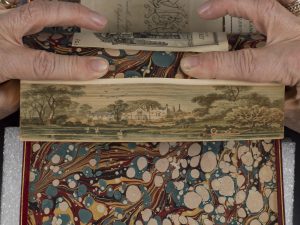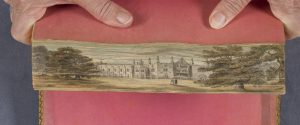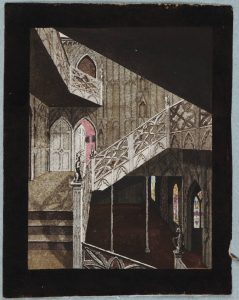Strawberry Hill and The Castle of Otranto: Fore-Edge Paintings at the Lewis Walpole Library
Dale Townshend, Professor of Gothic Literature, Manchester Metropolitan University
One of the greatest privileges of researching at the Lewis Walpole Library must surely be the opportunity to work alongside staff who have such a deep knowledge of, and palpable passion for, the collections that they oversee. Indeed, how thrilled I was when, systematically working my way through the catalogue’s unmatched holdings in eighteenth-century editions of The Castle of Otranto (1765), the obliging and ever-helpful Library Services Assistant Kristen McDonald introduced me to a number of crucial items that would otherwise have escaped my attention: three luxury, apparently unique eighteenth-century editions of Walpole’s fiction that include fore-edge paintings—detailed, decorative scenes painted on the edge of the book opposite to the spine and gilded over so as to render them invisible when the book is closed. Rather like the ghosts that populate the volumes of Gothic fiction that arose in Otranto’s wake, fore-edge paintings are invisible to the uninitiated and unbelieving eye. Instead, they reveal themselves only when they are known to be there, and even then, only when they are looked at awry, the pages of the book bent or folded over by the reader so as to show up their secret, spectral inscriptions. In all likelihood added to bound editions of Otranto subsequent to purchase, these fore-edge paintings were expensive, luxury embellishments to copies of the text that were probably intended as collectors’ items or gifts. Together, all three images have been indispensible to my current research on the relationship between Gothic architecture and Gothic fiction, poetry, and drama in the period 1760 to 1840, particularly for the insight that they yield into the ways in which the late eighteenth century perceived the relationship between Walpole’s fiction and his home at Strawberry Hill: as Walpole in the guise of the translator William Marshal teasingly suggested in the Preface to the first edition of The Castle of Otranto, ‘the scene is undoubtedly laid in some real castle’ (viii), a detail that, following his disclosure of authorship a few months later, pointed readers directly to his own ‘little Gothic castle’ at Twickenham.
The earliest of these in the library’s holdings occurs in a copy of the third edition of The Castle of Otranto: A Gothic Story that was published by John Murray in London in 1769 (LWL Call Number 24 17 769). The image provides a visual interpretation of the dark, labyrinthine recesses beneath the eponymous Castle, the space through which Manfred pursues the imperiled heroine Isabella. With its vaulted ceilings and rounded, heavy columns, the architecture of the scene represents what the eighteenth century designated as ‘Saxon Gothic’, the early Gothic style that Thomas Warton in the second, revised edition of his influential Observations on the Fairy Queen of Spenser (1762) described as consisting of ‘round arches, round-headed windows, and round massy pillars, with a sort of regular capital and base’ (vol. 2, 186). As W. S. Lewis would observe in his seminal article ‘The Genesis of Strawberry Hill’ (1934), however, the subterraneous passages of Walpole’s text remain a ‘fiction’, textual details, that is, that are entirely without precedent or anchorage in the ‘real’ architecture of Strawberry Hill (90).
By contrast, the fore-edge painting included in a copy of the fourth edition of The Castle of Otranto: A Gothic Story that was printed for J. Dodsley in London in 1782 (LWL Call Number: 24 17 782 Copy 3) is somewhat more determined in its attempts at tying the architecture of the fiction back to Walpole’s own home.
Though it is not architecturally precise, the image approximates a view of Strawberry Hill as seen from the River Thames. While drawing a clear visual link between Otranto and the famed house of its author, this fore-edge painting also anticipates the claim that Walpole himself would advance in the Preface to the second edition of A Description of the Villa of Mr Horace Walpole (1784), namely that Strawberry Hill was, at once, ‘a very proper habitation of’ and ‘the scene that inspired’ the author of The Castle of Otranto (iv).
The third fore-edge painting in the Library’s holdings is to be found in a copy of the sixth edition of The Castle of Otranto that was published by Bodoni in Parma, Italy, for J. Edwards in 1791 (Call Number 24 17 791P Copy 15). On the one hand, the building depicted here appears not to be Strawberry Hill at all, but rather a whimsical, Revivalist Gothic fusion of ecclesiastical and castellated architectural details that recall a similar mixture of architectural styles and purposes in The Castle of Otranto. On the other, it may represent a version of Strawberry Hill as seen from the South, a building that, itself, was as much ecclesiastical as fortified, but opened up and flattened out, here, into a two-dimensional strip.
When taken together, these images intensify the ruse with which Walpole in The Castle of Otranto was clearly engaged: not only the mystery concerning the text’s oneiric and purportedly ancient ‘Gothic’ origins, but also, as he put it in that famous letter from Strawberry Hill to William Cole in March 1765, the extent to which the architecture of the fiction included ‘some traits’ that would ‘put you in mind of this place’ (Correspondence, vol. 1, 88).
Bibliography
Lewis, W. S. ‘The Genesis of Strawberry Hill’, Metropolitan Museum Studies vol. 5,
no. 1 (August 1934): 57–92.
Lewis, W. S. (ed.). The Yale Edition of Horace Walpole’s Correspondence, 48 vols
(New Haven: Yale University Press, 1937–83).
Walpole, Horace. A Description of the Villa of Mr Horace Walpole, Youngest Son of
Sir Robert Walpole Earl of Orford, at Strawberry-Hill Near Twickenham, Middlesex. With an Inventory of the Furniture, Pictures, Curiosities, &c (Strawberry-Hill: Printed by Thomas Kirgate, 1784).
Walpole, Horace. The Castle of Otranto: A Gothic Story (London: Thomas Lowndes, 1765).
Warton, Thomas. Observations on the Fairy Queen of Spenser, 2nd edition, 2 vols
(London: Printed for R. and J. Dodsley; and J. Fletcher, Oxford).







